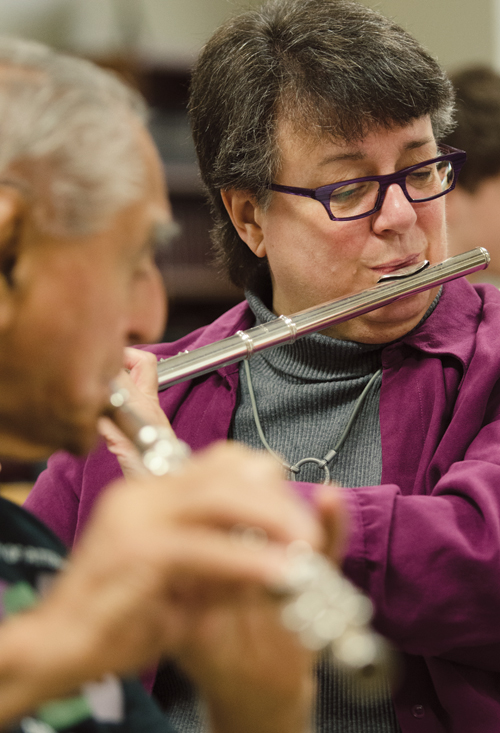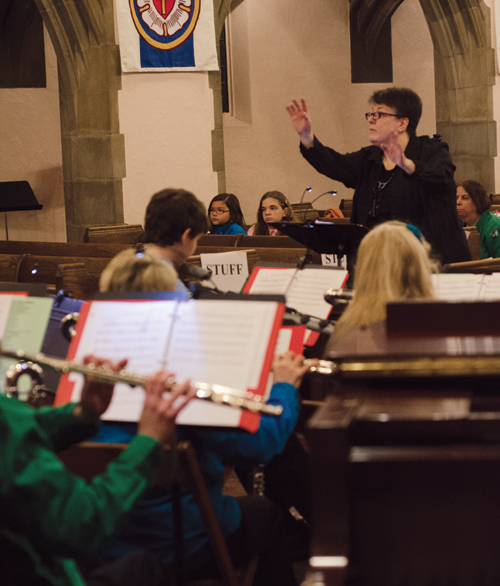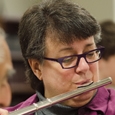
Wendy Webb Kumer has served the Pittsburgh Flute Club in every capacity and has been secretary of the Moyse Society and the National Flute Association. Kumer is the founder of The Flute Academy and regularly organizes flute choir performances with the Pittsburgh Symphony. With more than 40 years of teaching experience, she is devoted to flutists of all ages and levels and sincerely believes that world peace can be attained if there is a flute in every household. Kumer is a graduate of Duquesne University (Bernard Goldberg) and Carnegie Mellon University (David Cramer and Carole Morgan). She also attended Marcel Moyse’s seminars in Vermont. Kumer has played professionally in Pittsburgh area orchestras and has taught at Duquesne, Carnegie Mellon, and Mercyhurst College. She is currently on the faculty of West Liberty University.
What led you to start The Flute Academy?
By the age of 20, I already had a large studio. I knew that teaching flute was what I wanted to do. In January 1980 I started teaching at Duquesne with one student. The pay was $8.50 per hour and my parking was $4.00 per hour. After taxes, my paycheck was a wash, but my foot was in the door. In my youthful enthusiasm, I intended to create a flute empire with my community studio, and with the university students we would share resources to host guest flutists, present recitals, and start flute choirs. For the next 20 years, that is exactly what I did.
Within five years, I was able to recruit 12 flute majors including graduate students. We hosted numerous guest artists, including Lady Jeanne and Sir James Galway, William Bennett, Trevor Wye, Jeanne Baxtresser, Carol Wincenc, Bonita Boyd, Leone Buyse, Jonathan Snowden, Robert Dick, Per Oien, and Jim Walker. Also during that time Julius Baker was teaching at Carnegie Melon, so these were rich flute days in Pittsburgh. Many of my students (Karl Barton, Amy Orsinger Whitehead, Pamela Murchison, Dan Parasky, Lindsay Leach-Sparks, Torin Olsen, Gay Kahkonen, Megan Neal, T. J. Wible, and more) from those early days have built successful careers themselves.
In the mid-1990s the Duquesne music administration shifted away from having freelance musician as adjunct professors and began hiring Pittsburgh Symphony members to teach. Since the mid-1980s I had been teaching at Duquesne’s City Music Center where I had started community flute choirs and summer flute camps. So, I reinvented myself and dove into expanding my community student base and my middle, high school, and adult flute choirs at Duquesne. In 2000 another restructuring occurred at Duquesne and flutists could study privately only through the City Music Center where the tuition for a 30-minute lesson was a prohibitive $50. This got me thinking about creating a flute haven where flutists could study, practice, teach, play in flute choirs, have masterclasses, work with guest artists, attend recitals, participate in chamber ensembles and have access to recording facilities, all for a reasonable tuition rate. That spring, I was called for jury duty where I sat idly for days with only my laptop as a companion. Thus, The Flute Academy was imagined, the schedule created, and we opened in September 2001.
How is The Flute Academy organized?
It is a community of flute teachers who are like-minded and believe in the vision of flutists of all ages and levels of development getting together to make beautiful music, to learn, to grow, and to study. The teachers set up their own policies, calendars, lesson fees, and keep their own account books. Very low or no rent is charged if a teacher’s students enroll in the flute choir and other classes (music theory, ear training, and chamber music). Frequently we have interns from Carnegie Mellon and Duquesne who work with the flute choirs and classes to get some on-the-job training while still in college. Although the interns are paid only a small stipend, they are building a resume and gaining valuable experience. Several times a year, flute vendors come to The Flute Academy to show and sell instruments.
We are located at First Trinity Lutheran Church in the Shadyside section of Pittsburgh, adjacent to the University of Pittsburgh campus and within walking distance of Carnegie Mellon. Since I attend church there, the pastor and the congregation allow us to use their vacated school building. We have free parking and huge spaces for lessons, classes, and rehearsals. To get us started, I bought a grand piano for the sanctuary, some recording equipment, a high capacity copier, a subscription to Smart Music, an iPad, and had a business phone installed. As a member of the congregation, I make regular donations for the utilities, overall maintenance, and space usage. The Flute Academy is under the supervisory board of the Augsburg Academy, an educational branch of our congregation and is covered under the church’s liability insurance policy. The tuition from The Flute Academy students pays the staff, expenses, and a donation to the church each semester.
Lessons are taught each weekday after school. On any given day there may be piano lessons in the sanctuary, flute lessons in the studios, students using the recording studio for auditions and competitions, and of course, students finishing homework while waiting for lessons. We have free Wi-Fi for all to use. On Saturdays, there are piano, flute and violin lessons all day. The middle school flute choir, Flute Loops, and the high school flute choir, Flutations, rehearse for semester-end concerts, and the adult flute choir, City Flutes, meets every other Saturday. There are also Saturday chamber music rehearsals, makeup lessons, group classes, and theory and ear training.
We keep tuition reasonable so many flutists can afford to participate. Flute choir is $110 for students and $75 for adults for a 10-week semester. For the other classes the tuition is $100. Our goal is to have everyone want to come back and play their flutes for the rest of their lives.
Do most of your students enter competitions?
Goodness no! The Flute Academy mission is to provide quality music instruction through the teaching of the flute with the goal of students becoming life-long music lovers and concert attendees. We teach students of all ages, abilities, and interest levels. Each student I teach is my favorite one, ever. However, many of the students do enter and win competitions.
We have had numerous road trips with 15-passenger vans full of Kumer Kids of all ages competing in PMTA, MTNA, PMEA, and National Flute Association events. One student, T.J. Wible, won the MTNA National High School Woodwind competition in Salt Lake City and was a finalist in both the National Flute Association High School Soloist and piccolo competitions. From my studio I have had approximately 100 high school flutists win the NFA High School Flute Choir competition over the past 30 years.
For some students, entering a competition can be a motivation tool. If their skill level, practice habits and personality align in a proper proportion, I urge them to try out for something. If this appeals to them and it works as a motivator, we are off and running. About 15% of my flute students thrive in this environment. Some love learning the music, recording it, but never submitting the applications, and that is fine too. Part of my scrutiny into who is suited to this curriculum is a student’s (and family’s) attitude and definition of winning. We define winning as playing up to your expectations and noticing improvement since the last performance. We enjoy and often learn from reading judges’ comments but are not bound by them. Placing first or last is arbitrary and is not the goal.
Do you teach adults?
Yes. When I first started teaching, I was not keen on teaching adults. I could not relate to where they were in their lives with grown children and now returning to the flute after a long hiatus. I liked them, but didn’t get them. It is amazing how a few decades can change one’s perspective. I cherish my current, adult re-entry students. Their stories are fascinating because of their life experiences. I love that they still feel connected to the flute and flute music. This is one of the reasons why our 35-member adult flute choir, City Flutes, is so vibrant.

Organizing and conducting flute choirs has been a huge part of your life. What do you think is the future for flute choirs?
Flute choirs are our future. Check out the big flute choirs on YouTube (Netherlands Flute Academy, Korea and Japan). In 2006, I persuaded the National Flute Association to allow the 200-member Pittsburgh Flute Club flute choir to play as a pre-concert event on the Saturday evening gala with orchestra. Flutists from middle-school age through senior citizens played Kirk Vogel’s Secret Language of Snow to a packed audience. This is what it is all about.
Later that fall, more than 100 flutists from the Pittsburgh Flute Club played Irish music in venues around the symphony hall before the concert appearance of Sir James Galway and the Pittsburgh Symphony. Later that evening 35 flutists played the Galway Piper by David Overton on stage with Lady Jeanne and Sir James Galway. In 2009, the Pittsburgh Flute Choir (75 flutists) performed at the NFA Convention in New York City. This past fall, 150 flutists performed in the lobby of Heinz Hall just before a concert in which Pittsburgh Symphony principal flutist, Lorna McGhee, performed the Nielsen Concerto.
My next project is to gather as many as possible Pittsburgh Flute Club flutists and friends to perform at the Smithsonian National Zoo in Washington, DC on Saturday, August 15 during the NFA convention. We will perform Joe’s Treat by Gay Kahkonen, which was commissioned by the Pittsburgh Flute Club, and Kathy Blocki is also commissioning a piece. We are featuring Joe Bonadio, a soon-to-be 92-year-old beginner flutist. Bonadio attends everything flute-related within driving distance of Pittsburgh. Lorna McGhee has also promised to drop by for our zoo concert.
What was it like to study with Bernard Goldberg and Marcel Moyse?
Goldberg’s teaching was heavily influenced by Georges Barrère and Marcel Moyse. His curriculum included a firm technical foundation starting with the 17 Big Daily Exercises by Taffanel et Gaubert and etudes by Berbiguier and Andersen. He taught the French solos as well as compositions by Handel, Bach, Mozart, Kuhlau, and Demersseman. For tone color and phrasing he used the Moyse De La Sonorite and both the 24 Little Melodies with Variations and the 25 Melodies with Variations, in addition to Tone Development through Interpretation. He was a genius at teaching orchestral excerpts, as you might expect.
At Goldberg’s suggestion, I went to study with Marcel Moyse in Vermont for four summers. This was a life-changing event. I was in attendance when Moyse celebrated his 90th birthday with an orchestra concert (conducted by Blanche Honegger Moyse). Classes were held in his grandson’s art barn in the woods. Huge 1970s colorful oil paintings were stacked against all the walls, and we sat on folding chairs for at least five hours twice a day.
Moyse limped (slowest gait, ever) into the plywood building and made his way to the front, breathing loudly with lungs full of congestion. We all knew that every breath could be his last. But, as soon as he seated himself in his padded, rolling office chair, took a sip of what he proclaimed loudly as “whiskey,” a flutist or woodwind chamber ensemble would begin to play. Suddenly he was 40 years younger. He literally bubbled with life and energy. It was remarkable how Moyse danced and waved about. His gesturing was historic. His teaching was inspired, deep, insightful, and all about the color, phrase, composers’ intentions, and conveying the deepest meaning in your playing. He could be brutal, but it wasn’t personal. He was simply passionate about music. My dream during those heady days at the Moyse seminars was to do my part in continuing his legacy of teaching with my students. I have been blessed with many students, years of opportunities, and a thoroughly enjoyable and satisfying career.
* * *
Favorite Flute Choir Repertoire
Since most middle school flutists study in a public school band program, they are used to playing in unison. To become independent rhythmically and harmonically, I introduce students to flute choir literature that is in three or four parts. I carefully mark the breaths for each part and have them play each of the other parts at one time or another. If a student has a piccolo, I add piccolo on the top part. If a flutist is large enough to play alto or bass flute, we may add them into the mix also. The Flute Loops middle school flute choir also plays several pieces that they can perform with the high school group and then a few additional pieces they can play with the three combined flute choirs, including the adult ensemble.
The three combined choirs’ repertoire this spring includes: King’s Processional by Alexandra Molnar-Suhajda (self published), Beckett’s Whisper by Ron Korb (Nourse Wind), Brazilian Alleluia by Ralph Manuel (arranged by Wendy Kumer), and Colonel Bogey’s March by Alford (ALRY). Flutations and City Flutes combination repertoire includes: Flute 66 by Jonathan Cohen (self published), Fanfare 36 by Kelly Via (Nourse Wind), Unexpected Journeys by James-Michael Sellers (Flute.net), and Souvenir de Porto Rico by Gottschalk/Davis (Fall House Press).
Growing Up with Art
Wendy Kumer is the daughter of two graduates from the Art Institute of Pittsburgh. She thought everyone’s parents sketched restaurant patrons on napkins when out for dinner and designed elaborate covers for their children’s school projects. Wendy’s father, Frank Webb, a commercial art studio owner, studied watercolor painting in Maine every summer while she was growing up. His teacher, Edgar A. Whitney, was in his late eighties and led painting critique classes in the woods. The similarities between the painter’s classes and Moyse’s class were remarkable. Eventually Frank Webb became the teacher and now in his late eighties, teaches watercolor painting all over the world. Google Frank Webb to see his use of design, color, shapes, and textures – visual responses reflecting Moyse’s beliefs about musicality.





